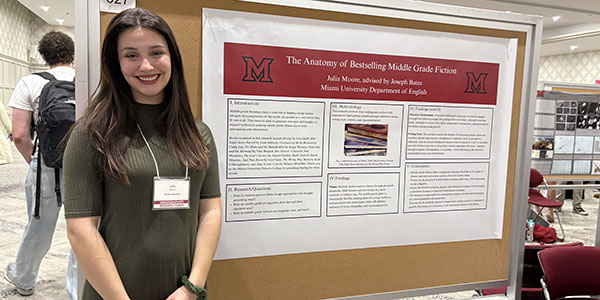Undergraduate researcher uncovers patterns in children’s literature
Student explores how middle grade fiction helps readers navigate the world around them

Undergraduate researcher uncovers patterns in children’s literature
Middle grade fiction follows a consistent pattern of character development where protagonists must relinquish limiting core beliefs to achieve personal growth, according to research by Julia Moore ’25, a Creative Writing major at Miami University. Moore’s analysis of recent bestselling middle grade literature examines how these books help young readers navigate complex issues and themes in an approachable and age-appropriate manner.
In her research project “The Anatomy of Bestselling Middle Grade Fiction,” Moore analyzed 11 middle grade books (literature written for readers between the ages of 8 and 12) published in 2023-2024 across multiple genres, including realistic fiction, fantasy, short stories, graphic novels, and poetry. Some of the most notable titles include “Plain Jane and the Mermaid” by Vera Brosgol, “The Liars Society” by Alyson Gerber, and “Shark Teeth” by Sherri Winston.
Moore’s analysis involved identifying and highlighting passages related to theme, writing style, content, and characterization. She then studied how authors used these elements to teach complicated ideas, like identity, to young readers.
Moore found that middle grade fiction is thematically flexible to allow young readers to explore serious, real-world issues. Middle grade literature “can help young readers learn about themselves and deal with some complex issues that they might not have the words for or know how to navigate on their own,” Moore said. She added that stories about difficult topics like parental alcoholism “helps them build empathy and learn how other people might be struggling with something they don’t see all the time.”
Moore also mapped a consistent formula for middle grade protagonists’ character development across narratives, themes, and subgenres — the protagonist faces challenges to a core belief, attempts to restore that belief lead to unintended consequences, and only by letting go of this belief can they experience personal growth. The vocabulary and emotional intelligence of the narrator is often heightened beyond what is typical of the reader’s age to convey the seriousness of what the protagonist is experiencing while still being relatable and accessible.
Moore’s interest in writing middle grade fiction herself led her to pursue this research project. Under the mentorship of associate professor of Creative Writing Joseph Bates, whom she approached in spring 2024, Moore is now applying her findings to her own novel in progress. Her work blends fantasy with the realistic scenario of a child who faces frequent moves and repeatedly being “the new kid.”
Using her research insights, Moore developed strategies to help other writers create middle grade fiction that is both entertaining and educational. These strategies focus on balancing complex subjects and themes with age-appropriate presentation.
Moore presented her findings at the Undergraduate Research Forum (URF) on April 25, where her creative writing project stood out among the predominantly scientific research displays in biology, zoology, psychology, and geology.
Bates described Moore’s work as inspiring. “This was an ambitious project even when we pitched it, but Julia met those requirements, then exceeded them, and then just kept going,” Bates said.
“That's exactly what you want to see with the work produced for the URF; it gives students the opportunity to explore interests and passions in a way regular coursework doesn't always allow, and the result is work that really shows off the drive and talent of our students. I know Julia is immensely proud of her accomplishment, as she should be, and I was very happy to see it showcased at the URF.”